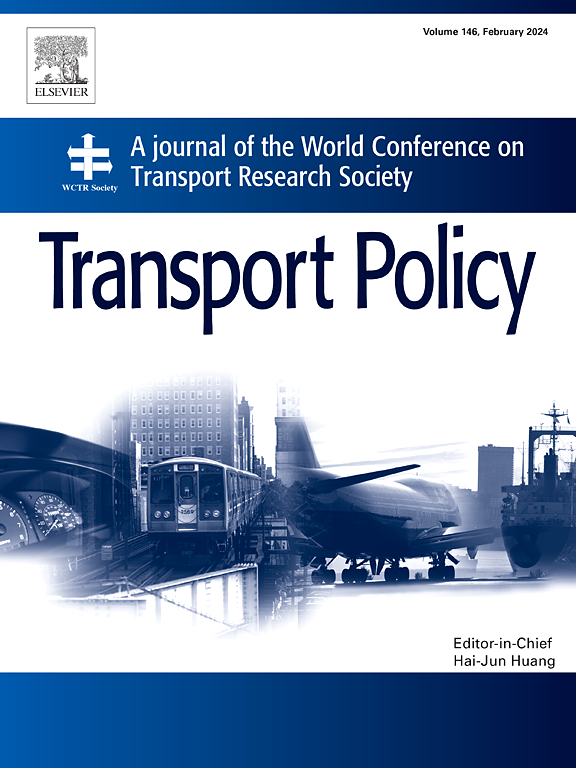发展公共交通会减少摩托车的使用吗?来自台湾的证据
IF 6.3
2区 工程技术
Q1 ECONOMICS
引用次数: 0
摘要
由于台湾六市重组后,大都市区经历了一段公共交通方式多样化的快速发展期,本研究采用纳入差异中差异(DID)方法的持续时间模型,评估2014 - 2018年台湾公共交通发展对摩托车使用的影响。它还调查了这种发展是否会导致骑摩托车通勤者使用公共交通工具的意愿增加。结果表明,公共交通的发展减少了摩托车的使用时间,特别是对于依赖地铁系统的摩托车骑行者和使用摩托车进行商业活动的摩托车骑行者。相反,公共交通的发展并没有减少摩托车通勤的使用。此外,公共交通发展对摩托车通勤者不同交通选择态度的影响在不同通勤人群中存在差异。在公共交通网络改善后,依赖地铁系统和每天摩托车使用时间小于30分钟的摩托车通勤者更倾向于开始使用公共交通工具。相比之下,那些每天使用摩托车超过60分钟的人表现出了下降的意愿。阻碍骑摩托车通勤者转向公共交通的主要因素是有限的便利性和机动性。因此,提高公共交通的便利性和可达性应该是优先考虑的。这些改进可能会减少人们不愿意从使用摩托车转向使用公共交通工具。进一步整合多种交通方式和促进绿色交通也应成为城市规划战略的关键考虑因素。本文章由计算机程序翻译,如有差异,请以英文原文为准。
Does developing public transportation reduce motorcycle Usage? Evidence from Taiwan
This study employed the duration model incorporating the difference-in-difference (DID) approach to assess the influence of the development of public transportation on motorcycle usage in Taiwan between 2014 and 2018, as the metropolitan areas had experienced a period of rapid development with diverse public transportation modes after the restructuring of Taiwan's six municipalities. It also investigated whether this development led to an increased willingness among motorcycle commuters to use public transportation. The results reveal that the development of public transportation reduced motorcycle usage time, especially for motorcyclists who were reliant on the metro system and those using motorcycles for business activities. Conversely, the development of public transportation did not reduce motorcycle usage for commuting. Furthermore, the effects of public transportation development on motorcycle commuters' attitudes toward different transportation options differed among various commuter groups. Motorcycle commuters depending on the metro system and with a daily motorcycle usage time of less than 30 min exhibited a greater inclination to begin using public transportation after public transit networks were improved. By contrast, those with a daily motorcycle usage time exceeding 60 min exhibited a decreased willingness. The primary deterrents for motorcycle commuters transitioning to public transportation were limited convenience and mobility. Thus, improving the convenience and accessibility of public transportation should be prioritized. Such improvements might reduce reluctance to transition from using motorcycles to using public transportation. Further integrating diverse modes of transportation and promoting green mobility should also be key considerations in city planning strategies.
求助全文
通过发布文献求助,成功后即可免费获取论文全文。
去求助
来源期刊

Transport Policy
Multiple-
CiteScore
12.10
自引率
10.30%
发文量
282
期刊介绍:
Transport Policy is an international journal aimed at bridging the gap between theory and practice in transport. Its subject areas reflect the concerns of policymakers in government, industry, voluntary organisations and the public at large, providing independent, original and rigorous analysis to understand how policy decisions have been taken, monitor their effects, and suggest how they may be improved. The journal treats the transport sector comprehensively, and in the context of other sectors including energy, housing, industry and planning. All modes are covered: land, sea and air; road and rail; public and private; motorised and non-motorised; passenger and freight.
 求助内容:
求助内容: 应助结果提醒方式:
应助结果提醒方式:


